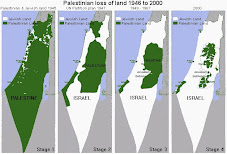Ma'an - Rubble covers the tile floor at the site of the demolished home we are beginning to rebuild in the East Jerusalem section of Anata, a Palestinian town divided between occupied "East" Jerusalem and the occupied West Bank.
Activists from the United States, Britain, Germany and Iran, reinforced daily by local Palestinian and Israeli activists, have gathered here for the Israeli Committee Against House Demolitions’ eighth annual summer rebuilding camp. They will spend two weeks rebuilding a Palestinian home that has been destroyed by Israeli authorities.
This year’s house, belonging to the Hamdan family, was first demolished in 2005. In 2007, ICAHD activists began rebuilding the home, but because it was located near a section of the separation wall under construction around Anata, battles of stone-throwing, tear gas, shooting and arrests erupted between the Palestinian residents resisting their virtual imprisonment behind 8 meter concrete blocks and the Israeli army and police.
Feeling endangered, ICAHD suspended the effort for an alternative site. In 2008, the ICAHD camp came back to the Hamdan home and completed its reconstruction. The house, however, was demolished again within a few months. Since our rebuilding constitutes political acts of resistance to occupation and not "humanitarian gestures," we try to rebuild every home that is re-demolished.
As we cleared the rubble from the foundation this morning, I noticed the tile floor that remained underneath. I was struck by the fact that the tiles were the same pattern as those we used last summer, when I participated in the ICAHD effort to rebuild a house a short distance away. I thought about the volunteers in 2007 and 2008, who had worked in the summer heat to build this home, only to have their work destroyed shortly after the family moved in.
Because the Spanish government is sending 45 volunteers this year to rebuild, a wonderful thing but something that would make a combined work camp unwieldy, ICAHD decided to operate three camps: this one in Anata with about 20 volunteers, one in the East Jerusalem neighborhood of Beit Hanina and one in the West Bank, near Hebron. Altogether we will build four houses this summer.
We made measurable progress today. After a nonviolence training session by members of the Palestine Solidarity Project based in Beit Ummar near Hebron, we took a walking tour of Anata, guided by Salim Shawamreh, ICAHD's field coordinator and resident of Anata, whose own home has been demolished four times.
We met residents on the way and got a feel for the place where we will be spending the next two weeks. On the tour, ICAHD Director Jeff Halper gave a broad political context, explaining how part of the village is under joint Palestinian-Israeli control (Area B), and part under full Israeli control (Area C).
Many of the homes in Anata are under constant threat of demolition because Israeli authorities claim they were constructed without the proper permits – which are virtually impossible to acquire. In fact, trhee Israeli government authorities demolish homes in Anata: the Jerusalem municipality, the Ministry of Interior and the Civil Administration, Israel's military government over the West Bank.
In the afternoon, the whole crew of volunteers went to the building site and got down to work, first cleaning the site, then forming human chains to pass along a seemingly endless stream of buckets of concrete to pour into molds for the foundation and pillars. At the end of the day we were treated to a sumptuous tray of baba ganoush, hummus, pickles and fresh-baked bread sent out to us by the mother of two teenage girls who had been watching our efforts.
We dragged our sweaty bodies home for dinner and a presentation from Jeff and Salim about the Israeli occupation and the history of Beit Arabiya, the house where we are staying. Salim explained the nightmarish and expensive process he repeatedly undertook in unsuccessfully trying to get a permit to construct the house, named after our hostess, Arabiya.
Their house has been standing since it was rebuilt by ICAHD in 2003, but because the family has Jerusalem residency and the home is in the West Bank, they will lose their right to enter Jerusalem if they move into their home – something especially worrying since there is currently another demolition order against it and they might be left without a home entirely.
So now it is used as a strategizing center, and the Shawamreh family only stays here during the ICAHD summer camp. More than 24,000 homes have been destroyed since the Israeli occupation began in 1967. ICAHD has rebuilt 165 over the past decade; only about 15 have been re-demolished.
Most camp participants are already involved in this work, but they come home from their experiences here energized and more determined to carry on their efforts. As Alaina, a volunteer from Portland, Oregon put it, “As Americans, there’s only so much we can do here, but there’s a lot we can do back there, because our tax dollars are funding this whole thing."
The ICAHD camps will send back into the world 65 effective advocates against the occupation and for a just peace by the end of work camp schedules. And four families, numbering several dozen people, will have homes.







